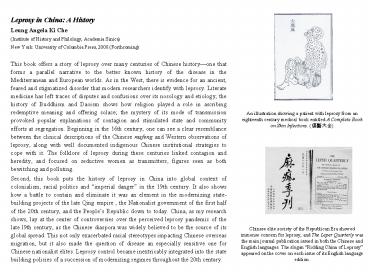Leprosy in China: A History - PowerPoint PPT Presentation
1 / 2
Title:
Leprosy in China: A History
Description:
This book offers a story of leprosy over many centuries of Chinese history one ... affliction believed to have haunted the civilization since time immemorial. ... – PowerPoint PPT presentation
Number of Views:40
Avg rating:3.0/5.0
Title: Leprosy in China: A History
1
- Leprosy in China A History
- Leung Angela Ki Che
- (Institute of History and Philology, Academia
Sinica) - New York University of Columbia Press, 2008
(Forthcoming) - This book offers a story of leprosy over many
centuries of Chinese historyone that forms a
parallel narrative to the better known history of
the disease in the Mediterranean and European
worlds. As in the West, there is evidence for an
ancient, feared and stigmatized disorder that
modern researchers identify with leprosy.
Literate medicine has left traces of disputes and
confusions over its nosology and etiology the
history of Buddhism and Daoism shows how religion
played a role in ascribing redemptive meaning and
offering solace the mystery of its mode of
transmission provoked popular explanations of
contagion and stimulated state and community
efforts at segregation. Beginning in the 16th
century, one can see a clear resemblance between
the clinical descriptions of the Chinese mafeng
and Western observations of leprosy, along with
well documented indigenous Chinese institutional
strategies to cope with it. The folklore of
leprosy during these centuries linked contagion
and heredity, and focused on seductive women as
transmitters, figures seen as both bewitching and
polluting. - Second, this book puts the history of leprosy in
China into global context of colonialism, racial
politics and imperial danger in the 19th
century. It also shows how a battle to contain
and eliminate it was an element in the
modernizing state-building projects of the late
Qing empire , the Nationalist government of the
first half of the 20th century, and the Peoples
Republic down to today. China, as my research
shows, lay at the center of controversies over
the perceived leprosy pandemic of the late l9th
century, as the Chinese diaspora was widely
believed to be the source of its global spread.
This not only exacerbated racial stereotypes
impacting Chinese overseas migration, but it also
made the question of disease an especially
sensitive one for Chinese nationalist elites.
Leprosy control became inextricably integrated
into the state building policies of a succession
of modernizing regimes throughout the 20th
century.
An illustration showing a patient with leprosy
from an eighteenth century medical book entitled
A Complete Book on Skin Infections. (????)
Chinese elite society of the Republican Era
showed immense concern for leprosy, and The Leper
Quarterly was the main journal publication issued
in both the Chinese and English languages. The
slogan Ridding China of Leprosy appeared on the
cover on each issue of its English language
edition.
2
- Finally, by linking the pre-modern and modern,
the local and the global, this book shows the
centrality of the Chinese experience to the
history of disease, public health, and the spread
of biomedical regimes of power around the world.
The social and cultural formations surrounding
leprosy as an endemic disease were specific to
China, and the historical record surrounding it
is particularly rich and detailed. Even after
missionary and colonial agents brought 19th
century science to China, strategies to deal with
it were shaped by traditional ways of considering
this mysterious and horrifying affliction
believed to have haunted the civilization since
time immemorial. This specific history in turn
determined Chinese reactions to the late l9th
century health crisis leprosy presented as it
emerged in the context of both colonialism and an
emerging biomedically-governed global public
health movement. It is a history that reveals
Chinese agency in understanding and attempting to
control the disease in the face of the growing
hegemony of Western science and medicine. While
the modern story casts a critical eye upon
public health movements as regimes of power,
Chinese engagements with the curse of leprosy
also reveal the allure of hygienic modernity
for elites in societies struggling to overcome
the stigma of backwardness with which the disease
came to be identified. - Chinas history of leprosy provides a
particularly informative alternative to the
master narrative of modernity as defined by
European experience. In this sense, this book
is an attempt of provincializing Europe. The
history of Chinese understanding of the ailment
and the changes in her strategies to control it
should thus be read as one of the dynamic,
multisited histories of postcolonial medicine.
For a civilization such as China, to appreciate
her construction of a hybrid modern regime of
health management requires not only the grasp of
the nature of her unique political regime since
the late 19th century, but, above all, the
understanding of her long and complex medical,
religious and social traditions since Antiquity.
The long and unbroken story of mafeng/lai
certainly provides one of the most useful keys
for such an appreciation.
Beginning in the early Republican Era, all sorts
of inventions which combined traditional
Chinese healing methods with Western technology
for the cure of leprosy began to appear. (This
illustration was published in the June 1937
edition of The Leper Quarterly.)
In the Republican Era, many Christian
missionaries established asylums for patients of
leprosy. These asylums were often located in
remote mountain areas or on deserted islands. The
leprosy asylym on Tai-kom island of Guangdong
province was established in 1919, and began
publishing its own journal in the 1930s.































